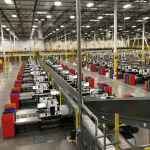Streamline Returns Management

In today’s new era of customer-driven ecommerce, understanding and applying solutions to the reverse loop can save etailers a large percentage of their profit. Not to mention time, space, and even brand preference for the ecologically driven buyer. Return rates in retail and ecommerce reach 20% on average and and can peak at 30% during holiday seasons.
Challenge:
Returns management, or reverse logistics, has typically been a paper intensive operation. S&H Systems developed a simple, yet highly effective operation that processed 3600 return items per hour – with future growth expectations of up to 5600 units per hour. Additional requirements were maximum up time in a 24/7 operation and reduced task labor.
Solution: Create a flexible, modular system designed for maximum efficiency
1. Decanting:
- Returned items are fluid unloaded from inside a trailer using extendable conveyors. Each carton conveys to one of four decanting workstations where associates remove the dunnage and placed onto an ECC (empty corrugate conveyor) takeaway conveyor that feeds a dunnage auger.
- The decanted cartons are accumulated and fed into one of 18 processing workstations. Here associates scan the product and place it in a color-coded tote – each representing a destination for technical grading, vendor returns, liquidate and destroy, trans-out shipment, etc. The empty corrugate is placed on an overhead ECC takeaway conveyor that feeds an auger.
2. Empty Corrugate Processing and Metal Detection:
- Each ECC system is equipped with a metal detector, with capabilities of up to size AA battery, and will stop the system if metal is detected. The system is designed to prevent a fire within the auger system.
3. Processing of Returned Items:
- An associate releases the tote from their workstation using a decline gravity conveyor section that merges onto a takeaway conveyor. Each of the 18 stations convey out of processing and up an incline belt conveyor and merge through a sawtooth conveyor and on to the main trunk line. Downstream, each tote is scanned and assigned a lane for final processing.
- Here associates determine if the product is re-saleable, needs to be destroyed or can be shipped to another fulfillment center for re-distribution.
Benefits/End Result:
- The end user achieved a maximum throughput rate of 5600 units per hour with minimal downtime. S&H Systems’ design reduced sorting errors (even exceeding the initial design rate) and helped the client achieve ROI in under 12 months.
